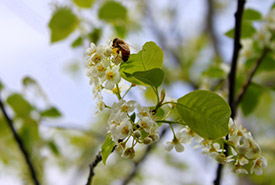Bring bees back to your garden

Bee pollinating a cherry tree (Photo by Jaimee Morozoff, NCC staff)
A few weeks ago, my mother texted me a photo of a shallow bowl with some rocks that she had set up beside her flowerbed. I didn’t have a clue what it was, and I told her as much.
“It’s for my bumblebee,” she replied. “I saw it on Facebook.”
Turns out, the mysterious item was a homemade bee bath. She told me that a bumblebee had been visiting her flowers, and she’d read an article on the internet that explained that bees need someplace safe to land and drink without drowning.
“Is there only one bee?” I asked her.
“That’s all I ever see,” she told me.
Some of my friends had made casual remarks about declining bee populations over the course of the summer but it wasn’t something about which I had given much thought. It’s like reading a news story about an event that’s happening a world away, and even though it’s interesting, there’s no personal stake. Then one day it affects somebody you know, and then the situation materializes into sudden clarity.
For some reason, hearing my mom tell me that there was single, lonely bumblebee visiting her garden struck me as very sad.
I began to research bees that afternoon, and quickly found myself pulled into the fascinating world of bees. Hopefully this information will inspire you the same way it did me.
So, what’s all the buzz about?
When you think of bees, you might think of honey bees. But did you know that honey bees are imported from Europe? Native Canadian bees do not produce honey. Unlike their European cousins, they usually live in the ground instead of in hives. Many Canadian bees are solitary and not all species are aggressive or sting. In Canada alone, there are over 800 species of native bee. They come in a wide range of shapes and colours, and most of their populations are in decline.
Bees are critical to our ecosystem. Plants reproduce through the transfer of pollen between flowers, and this is the most important service that native bees provide. Over 80 per cent of the world’s plants require wild pollinators for fertilization. One third of the things we consume — fruits, nuts, vegetables and herbs — depend on pollinators, primarily bees.
In recent years, there has been a massive decline in bee populations. Because European honey bees are often kept domestically, it’s been easier to see the loss of these imported bees. This phenomenon, labelled Colony Collapse Disorder, has put honey bees in the headlines, but less well-documented is the peril our native species are now facing as well.
There has been plenty of speculation surrounding the decline of our bees. Increasingly extreme weather may be one cause, and sprawling human populations means fewer bee-friendly meadows, among other theories.
Because our wild bee populations are difficult to count it’s hard to estimate how severely the native species are suffering, but areas that once had an abundance of bees are now seeing only a fraction of their former populations. Earlier this spring, the Committee on the Status of Endangered Wildlife in Canada added two bee species to the Species at Risk List: the western bumble bee, which has reached threatened status, and a species of bumble bee, which has not been seen in Canada since 2008 and has been labelled endangered. The rusty-patched bumble bee, once plentiful across southern Ontario and Quebec, has only been spotted three times in the past decade and is in danger of extinction.
The loss of our native bees would have a cascading effect. Although flies, wasps and moths also pollinate plants, wild bees are our principal pollinators, and without bees many plant species would have difficulty reproducing. The direct and most dramatic effect on humans would be the decline of many of the crops we depend on for food. In order to sustain these crops they would have to be manually pollinated by humans, resulting in higher food costs.
Oh no! How can I help?
Native bees live everywhere, in both rural areas and big urban cities. Bees thrive in cities because the abundance of gardens means shorter flight paths and plenty of flowers to feed from. They also do well in areas like backyards, patio gardens and farms that support numerous crops.
Bees in decline? Fortunately, bees are easy to please, and even a small effort can make a big difference! (Tweet this!)
Fortunately, bees are easy to please, and even a small effort can make a big difference. Even a small garden or a few potted plants can help, as long as you follow a few simple rules.
The first rule to attracting bees to your garden is to create a healthy habitat for your friendly neighbourhood pollinators. Like most living things, bees have three basic needs, and by addressing each of these you’re sure to draw pollinators to your yard:
- Food
- Shelter
- Fresh water
- Food
Bees consume two food sources: nectar (for sugar, which is the main source of their energy) and pollen (which contains proteins and fats).
As a rule, native plants attract native bee species, so be sure that your garden contains indigenous plants. Non-native flowers that are bred to be pleasing to people are sometimes sterile and of little use to native pollinators.
Bees have good vision and they love bright colours, especially blue, purple, yellow and white. When planting various types of flowers, plant the same kinds in patches so the bees don’t have to fly around the garden to find them.
The best bee-friendly gardens have a range of plants that bloom throughout the season. Look for some plants that flower in the spring, summer and late fall.
Much like us, bees come in all shapes and sizes. Some species have long tongues and some have short tongues, so plant different-sized flowers to feed multiple species.
Fresh water
Bees need to drink too, but they are rarely capable of landing in bird baths without crashing so they need islands to land on.
Create your own bee bath by placing rocks in a shallow bowl and leaving it at ground level. Add water, but be sure the rocks remain dry for the bees to land on. Add fresh water every day to keep your bees happily watered, and soon you’ll have the most popular bee bar in town.
Shelter
There are many different species of bee in Canada, and they each have their own habitat requirements. Most bees prefer sunny areas with some protection from the wind.
The majority of Canadian bees are solitary and nest in holes to raise their offspring. They look for out-of-the-way places protected from cold, wind and flooding. Others are more social and live in colonies.
Mason bees are docile, friendly native pollinators that don’t sting and can be raised with minimal effort. You can buy or build a bee home (learn how here or here) to encourage these busy bees to move in, or buy them from your local nursery. Building bee homes with your kids can be a fun and educational experience, but if you plan to build more than one bee home, paint them different colours so the bees can recognize which ones is theirs.
Some people prefer to leave the bee homes alone during the winter and let nature run its course, but your bees are more likely to survive if you eliminate parasites and risks to the colony by caring for the cocoons during the winter months.
Whether you have a large sunny garden or a small potted plant, every bit of habitat helps our native species!
What is NCC doing?
As part of the Nature Conservancy of Canada's (NCC’s) conservation planning process, once a property is secured staff and volunteers create inventories to document species that are present on the property. This includes listing the plants, birds, animals and insects on a property. This information helps inform NCC’s management of the properties.
One common management activity on most NCC properties is the removal of non-native plants. Removing these pants helps protect and maintain the native species on in the habitat, including the bees and pollinating insects. NCC also hosts many events, tours and workshops where staff share with landowners and participants the important and essential role that pollinators play in everyone’s life.
And so, in conclusion
I think my mother was taken aback by my crusade for native bees that our initial conversation inspired. As my research unfolded and I continued to discover all the small ways she could help out our native bees, I sent her a flurry of information she probably didn’t expect or necessarily need to know. I emailed her lists of native flowers to plant throughout the season and specifications to build her own bee home and texted her random bee facts with absolutely no lead up or context.
My mother had no interest or intention of ever building her own bee home, but when she was coming home from the Canmore Folk Music Festival a few weeks ago she send me an image of a mason bee box and the caption: “My folk fest purchase.”
And then one day we were talking on the phone and out of the blue, she told me “I saw two bees on my flowers today!”
Sometimes it’s the small things that cause us the most joy.


